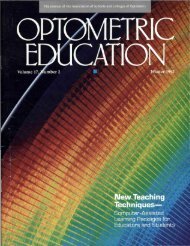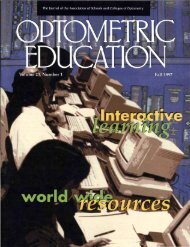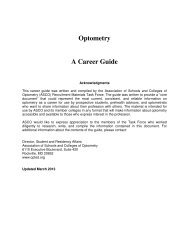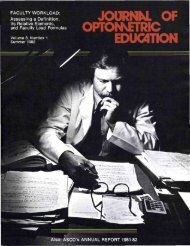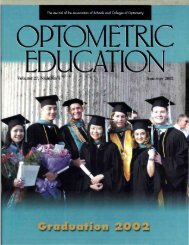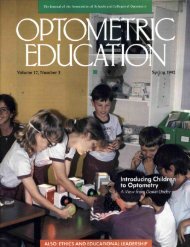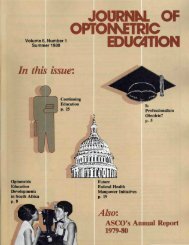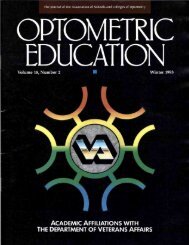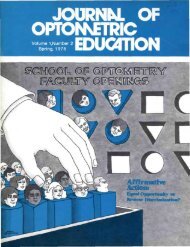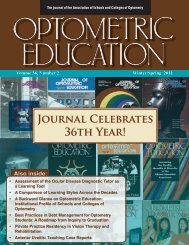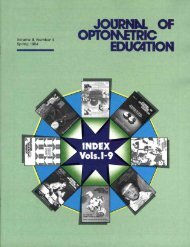Summer 2012, Volume 37, Number 3 - Association of Schools and ...
Summer 2012, Volume 37, Number 3 - Association of Schools and ...
Summer 2012, Volume 37, Number 3 - Association of Schools and ...
You also want an ePaper? Increase the reach of your titles
YUMPU automatically turns print PDFs into web optimized ePapers that Google loves.
Comparing Proportional<br />
Estimates <strong>of</strong> U.S.<br />
Optometrists by Race<br />
<strong>and</strong> Ethnicity with<br />
Population Census Data<br />
Elizabeth Edmiston Chen, MBA, MPH, FAAO<br />
Abstract<br />
The purpose <strong>of</strong> this paper is to characterize optometrists in the United States<br />
based on race <strong>and</strong> ethnicity. A 40-year record <strong>of</strong> students enrolled in doctor <strong>of</strong><br />
optometry programs in the United States was used to estimate proportions, which<br />
were then compared with Census 2010 data. Black <strong>and</strong> Hispanic optometrists<br />
comprise a substantially lower proportion when compared with the population.<br />
Non-Hispanic White <strong>and</strong> Asian optometrists are a higher proportion than the<br />
population. This is the first effort to estimate the racial <strong>and</strong> ethnic mix <strong>of</strong> the<br />
pr<strong>of</strong>ession.<br />
Key Words: optometrists, racial, ethnic, disparity, clinician, demographics<br />
Elizabeth Edmiston Chen is a Visiting Pr<strong>of</strong>essor at the Massachusetts College <strong>of</strong> Pharmacy <strong>and</strong><br />
Health Sciences. She was President <strong>of</strong> the New Engl<strong>and</strong> College <strong>of</strong> Optometry from 2006 to<br />
2009 <strong>and</strong> is currently active on various boards <strong>of</strong> directors in public education <strong>and</strong> social service<br />
policy. She conducts research independently <strong>and</strong> has been an invited guest lecturer at colleges <strong>and</strong><br />
universities in the Boston area.<br />
+<br />
Consistent with the U.S. Census, “race” in this paper refers to White, Black, Asian, American Indian/<br />
Alaska Native, <strong>and</strong> Native Hawaiian/Pacific Isl<strong>and</strong>er. “Ethnicity” reflects a common cultural heritage.<br />
The U.S. Census captures Hispanic or Latino ethnicity in addition to race. Used interchangeably by the<br />
U.S. Census, Hispanic or Latino reflects “a person <strong>of</strong> Cuban, Mexican, Puerto Rican, South or Central<br />
American, or other Spanish culture or origin regardless <strong>of</strong> race.” 1<br />
Introduction<br />
OIn the medical pr<strong>of</strong>essions,<br />
shared race <strong>and</strong> ethnicity + between<br />
clinicians <strong>and</strong> patients<br />
have been shown to improve<br />
communication <strong>and</strong> result in greater<br />
patient satisfaction, improved quality<br />
<strong>of</strong> care, improved access, <strong>and</strong> higher retention<br />
in care. 2-8 The literature exploring<br />
whether shared race <strong>and</strong> ethnicity in<br />
the physician/patient dyad could play a<br />
role in reducing health disparities experienced<br />
by Hispanic <strong>and</strong> Black patients<br />
shows that minority patients are likely<br />
to choose minority physicians, <strong>and</strong> minority<br />
physicians are likely to have a<br />
disproportionately large share <strong>of</strong> minority<br />
patients when compared with their<br />
non-minority colleagues. 3,9,10 Underst<strong>and</strong>ing<br />
the demographics <strong>of</strong> the optometric<br />
pr<strong>of</strong>ession, then, is important<br />
in planning the educational pipeline <strong>of</strong><br />
future optometrists, both for recruitment<br />
<strong>of</strong> any under-represented groups<br />
<strong>and</strong> for development <strong>of</strong> curricula to<br />
bridge patient or clinician perceptions<br />
leading to unintended bias in clinical<br />
care. These biases are not only in one<br />
direction. They can originate from the<br />
patient or from the clinician. 11,12<br />
A review <strong>of</strong> literature <strong>and</strong> government<br />
<strong>and</strong> private sources <strong>of</strong> data shows that<br />
little is available to characterize the<br />
demographics <strong>of</strong> today’s “clinician-optometrists,”<br />
i.e., optometrists who are<br />
primarily engaged in caring for patients.<br />
Throughout this paper, “optometrist”<br />
is used to refer to “clinician-optometrists,”<br />
<strong>and</strong> intended to exclude those<br />
primarily engaged in non-patient-care<br />
activities.<br />
In the late 1960s, the National Center<br />
for Health Statistics sponsored The<br />
1968-69 Vision <strong>and</strong> Eye Care Manpower<br />
Survey. 13 The study estimated that there<br />
were 20,300 doctors <strong>of</strong> optometry in<br />
the United States, <strong>and</strong> 91% were in active<br />
practice. The median age was 47.5;<br />
3% were female; nearly 90% were in<br />
private practice. The study did not collect<br />
race <strong>and</strong> ethnicity data. The American<br />
Optometric <strong>Association</strong> (AOA), an<br />
organization that frequently advocates<br />
for political issues <strong>of</strong> importance to the<br />
pr<strong>of</strong>ession, also does not collect race <strong>and</strong><br />
ethnicity information on its members. 14<br />
Its Workforce Study <strong>of</strong> Optometrists estimates<br />
39,228 optometrists in the year<br />
2011. Age <strong>and</strong> sex are available, but not<br />
Optometric Education 107 <strong>Volume</strong> <strong>37</strong>, <strong>Number</strong> 3 / <strong>Summer</strong> <strong>2012</strong>



